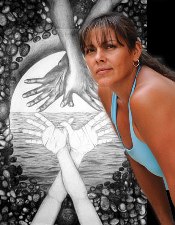In Saskatchewan, long-present landmarks and sacred objects can be found alongside the trappings of contemporary life: buffalo rubbing stones, tipi rings and medicine caches reside a few kilometres from recently-built cities. The interplay of past and present, on the land and within people, is the subject of Saskatchewan-based artist and art history professor Mary Longman‘s art and research.
Longman is from the Saulteaux nation, and was born in Fort Qu’Appelle, Saskatchewan. As a young child, she lived with her family on the Gordon First Nation reserve in Saskatchewan and in a Métis community near Lebret. Between the ages of five and sixteen, Longman and her sister were placed in permanent foster care. At sixteen she reconnected with her biological family and spent 10 more years locating her other five siblings, who had also been put into foster care.
In her most recent work, on display at the Mendel Art Gallery in Saskatoon, Longman uses digital technology to create 3-D lenticular images that present Aboriginal and colonial narratives. As the viewer walks past, the artworks flip back and forth between Aboriginal and colonial images from the past and present.
In this exhibit, Longman uses the lenticular image technology, probably best known from Crackerjack box pictures, to ingeniously transform still images into dual worlds in which colonial and Aboriginal narratives are contrasted and co-exist. As the viewer experiences the images flipping back and forth in these artworks, Aboriginal representations begin to emerge from under the shadow of the colonial master narrative.
Longman’s passion for art began at a young age, and she excelled in it from the time she started school. In 1989, she graduated from the Emily Carr Institute of Art and Design, and then completed an MFA at the Nova Scotia College of Art and Design, followed by a Ph.D. in art education at the University of Victoria, which she completed in 2006.
Longman is primarily a sculptor, and uses naturally-shaped stones in her sculptures. Her use of stone reflects her extensive knowledge of the Aboriginal cultural and art history of the plains region, where stone played a central role until this century.
“My people used to make small sculptures using rock, and they painted on stone as well. People also had tiny stones that were like amulets. Some were carved while others were chosen because of their special shape. I use stone as is — in its natural form. I want to revive the use of stone through my art, for means of communication and as land marks of a time and place.”
The sculpture Ancestors Rising, commissioned by the MacKenzie Art Gallery and found in its sculpture garden, is an example of how Longman uses natural stone in her art. The sculpture consists of a circle of four huge bronze bison horns, each positioned in one of the four directions: north, south, east and west.
From these horns extends braided rope made of copper patina. The copper rope forms a basket that cradles stones, which allude to the burial sites of plains people, and the use of stones in the cultural and practical activities of Aboriginal plains life, up until this century.
As an historian of Aboriginal art, Longman specializes in digital restoration and dating of pictographs, especially those from British Columbia.
Rock art, in the form of pictographs (rock paintings) and petroglyphs (rock carvings), can be found all over Canada. The drawings and carvings date back thousands of years.
Longman travels to remote areas, such as British Columbia’s Stein Valley, to photograph pictographs. She then processes her digital photos using de-correlation software, and uncovers details in faded pigments that have been hidden for hundreds of years.
The details that are once again visible provide the First Nations descendants of those who created the paintings, as well as other rock art experts, with a deeper understanding of the ancient cultures and stories of the region, many of which live on in contemporary Aboriginal communities.
“The next step is to use a method that x-rays the pictographs — I am trying to figure out how to use x-ray technology on rocks. This technology is currently used to determine if old paintings have other paintings under them.”
Along with photographing and digitally restoring pictographs, Longman is writing a book about the art of the Interior Salish people of British Columbia, which include the Secwepemc (Shuswap), Lilouet and Nlaka’pamux nations.
Longman also encourages dialogue about Aboriginal art through her role as professor of contemporary and historical Aboriginal art history at the University of Saskatchewan.
She is currently developing eight new aboriginal art history courses for the University of Saskatchewan. Her objective is to create the first minor in Aboriginal art history in Canada.
“By teaching Aboriginal art, and teaching through my own art, I hope to provide this generation with foundational knowledge of the Aboriginal peoples of this land, and of art history in general.”
Longman’s exhibit of new work will be on display at the Mendel Art Gallery from September 25, 2009 to January 10, 2010.



